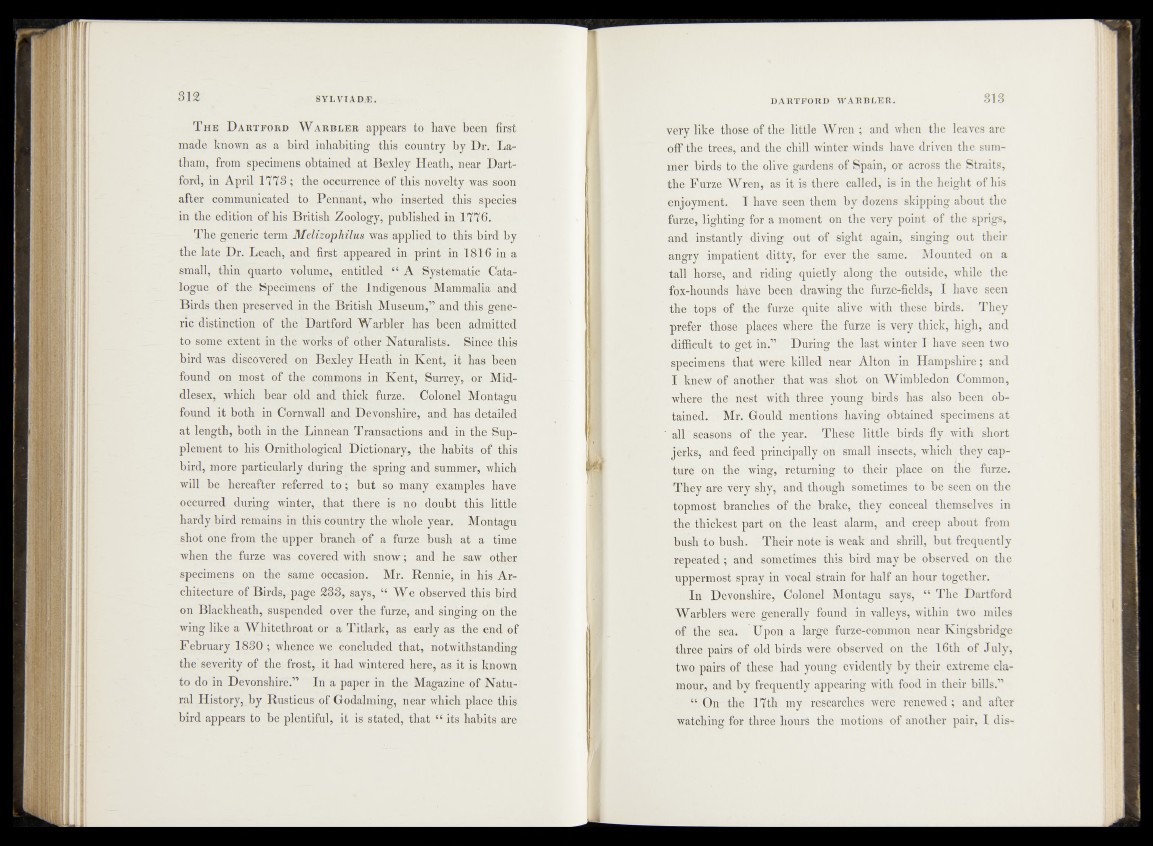
T h e D a r t f o r d W a r b l e r appears to have been first
made known as a bird inhabiting this country by Dr. Latham,
from specimens obtained at Bexley Heath, near Dart-
ford, in April 1773; the occurrence of this novelty was soon
after communicated to Pennant, who inserted this species
in the edition of his British Zoology, published in 1776’.
The generic term Melizophilus was applied to this bird by
the late Dr. Leach, and first appeared in print in 1816 in a
small, thin quarto volume, entitled “ A Systematic Catalogue
of the Specimens of the Indigenous Mammalia and
Birds then preserved in the British Museum,” and this generic
distinction of the Dartford Warbler has been admitted
to some extent in the works of other Naturalists. Since this
bird was discovered on Bexley Heath in Kent, it has been
found on most of the commons in Kent, Surrey, or Middlesex,
which bear old and thick furze. Colonel Montagu
found it both in Cornwall and Devonshire, and has detailed
at length, both in the Linnean Transactions and in the Supplement
to his Ornithological Dictionary, the habits of this
bird, more particularly during the spring and summer, which
will be hereafter referred to ; but so many examples have
occurred during winter, that there is no doubt this little
hardy bird remains in this country the whole year. Montagu
shot one from the upper branch of a furze bush at a time
when the furze was covered with snow; and he saw other
specimens on the same occasion. Mr. Rennie, in his Architecture
of Birds, page 233, says, “ We observed this bird
on Blackheath, suspended over the furze, and singing on the
wing like a Whitethroat or a Titlark, as early as the end of
February 1830; whence we concluded that, notwithstanding
the severity of the frost, it had wintered here, as it is known
to do in Devonshire.” In a paper in the Magazine of Natural
History, by Rusticus of Godaiming, near which place this
bird appears to be plentiful, it is stated, that “ its habits are
very like those of the little Wren ; and when the leaves are
off the trees, and the chill winter winds have driven the summer
birds to the olive gardens of Spain, or across the Straits,
the Furze Wren, as it is there called, is in the height of his
enjoyment. I have seen them by dozens skipping about the
furze, lighting for a moment on the very point of the sprigs,
and instantly diving out of sight again, singing out their
angry impatient ditty, for ever the same. Mounted on a
tall horse, and riding quietly along the outside, while the
fox-hounds have been drawing the furze-fields, I have seen
the tops of the furze quite alive with these birds. They
prefer those places where the furze is very thick, high, and
difficult to get in.” During the last winter I have seen two
specimens that were killed near Alton in Hampshire; and
I knew of another that was shot on Wimbledon Common,
where the nest with three young birds has also been obtained.
Mr. Gould mentions having obtained specimens at
' all seasons of the year. These little birds fly with short
jerks, and feed principally on small insects, which they capture
on the wing, returning to their place on the furze.
They are very shy, and though sometimes to be seen on the
topmost branches of the brake, they conceal themselves in
the thickest part on the least alarm, and creep about from
bush to bush. Their note is weak and shrill, but frequently
repeated ; and sometimes this bird may be observed on the
uppermost spray in vocal strain for half an hour together.
In Devonshire, Colonel Montagu says, “ The Dartford
Warblers were generally found in valleys, within two miles
of the sea. Upon a large furze-common near Kingsbridge
three pairs of old birds were observed on the 16th of July,
two pairs of these had young evidently by their extreme clamour,
and by frequently appearing with food in their bills.”
“ On the 17th my researches were renewed ; and after
watching for three hours the motions of another pair, I dis